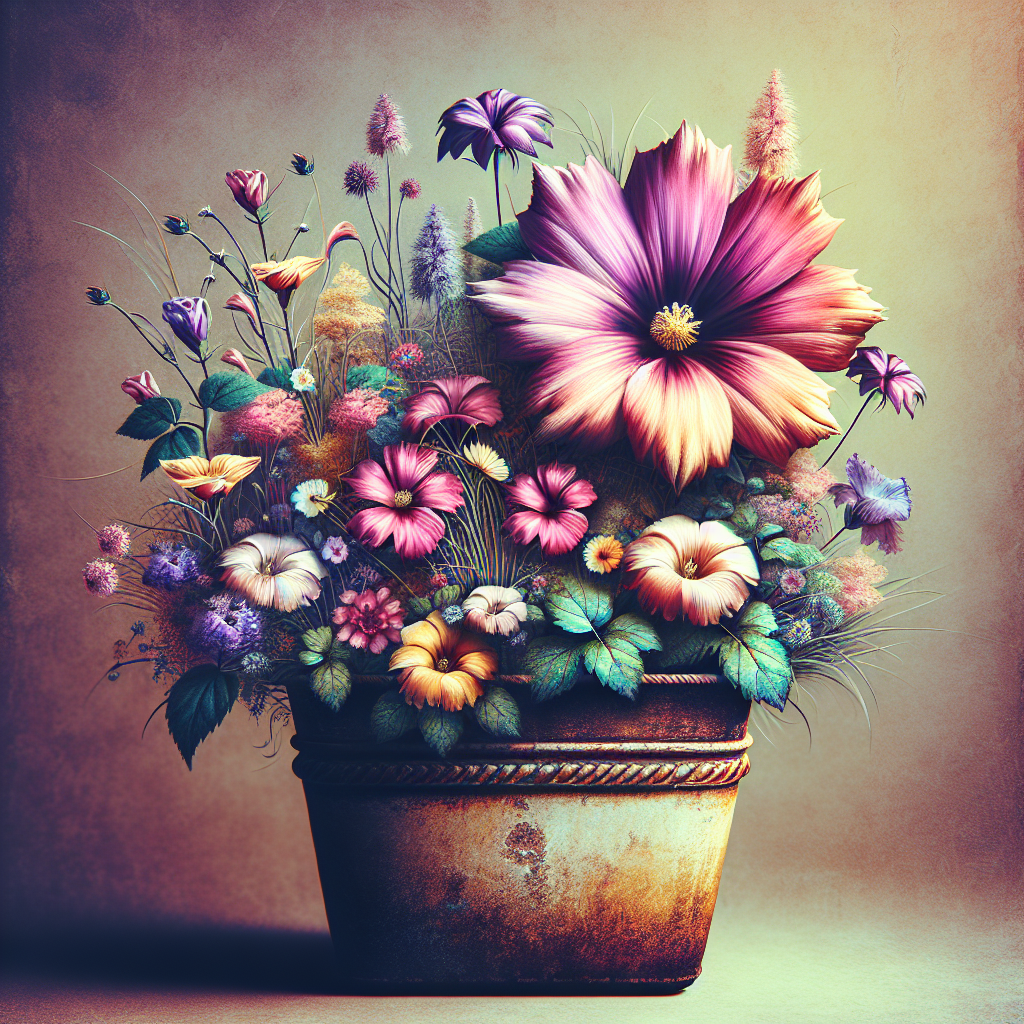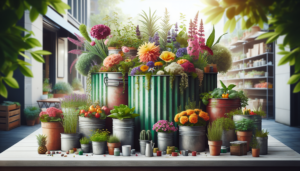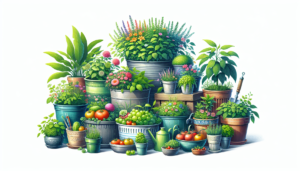
If you’ve ever dreamt of creating a lush garden but lack the space or resources, container gardening might just be the answer you’ve been looking for. This article will take you on a journey through the world of container gardening, offering you invaluable tips and techniques to cultivate your own little oasis. From choosing the perfect containers to selecting the right plants and providing them with optimal care, you’ll soon find yourself immersed in the art of container gardening, bringing beauty and greenery to even the tiniest of spaces. So grab your gardening gloves and get ready to embark on an adventure filled with vibrant colors, fresh fragrances, and the joy of nurturing nature within the confines of a container.
Choosing the Right Containers
When it comes to container gardening, one of the first things you need to consider is the size and material of the containers you will use. The size of the container should be appropriate for the plants you wish to grow. Larger plants require larger containers with more room for root growth, while smaller plants can thrive in smaller pots. Additionally, the material of the container is important for various reasons. Clay pots are porous and allow for better air circulation, but they can also dry out quickly. Plastic, on the other hand, retains moisture better but may not be as aesthetically pleasing. Consider these factors when selecting your containers.
Another crucial aspect to consider is whether the containers have proper drainage. Adequate drainage prevents water from pooling at the bottom of the container, which can lead to root rot and other issues. Look for containers with drainage holes or be prepared to drill your own. Additionally, placing a layer of rocks or pebbles at the bottom of the container can help improve drainage.
While functionality is important, don’t forget to think about the aesthetic appeal of the containers. Container gardening is a chance to showcase your creativity and personal style. Choose containers that complement your outdoor space and bring visual interest to your plants. Consider different shapes, colors, and textures to create a visually pleasing container garden.
In the spirit of sustainability, reusing and repurposing containers can be a wonderful approach to container gardening. Look around your home for items that can serve as containers, such as old buckets, barrels, or wooden crates. Not only does this reduce waste, but it also adds a unique touch to your garden. Just make sure these containers meet the size and drainage requirements for your plants.
Selecting the Perfect Plants
Before diving into container gardening, it’s important to research the needs and requirements of different plants. Not all plants thrive in containers, so make sure to choose ones that are suitable for this type of gardening. Consider factors such as the amount of sunlight and space available in your outdoor area. Some plants require full sun, while others can tolerate more shade. Assess the conditions of your space and select plants accordingly.
To create an aesthetically pleasing container garden, you can mix and match plants with varying heights, colors, and textures. By combining plants with contrasting attributes, you can create visually dynamic arrangements. For example, pairing tall, upright plants with trailing, cascading ones can add depth and dimension to your containers.
Don’t limit yourself to just one type of plant. Container gardening offers the opportunity to explore the versatility of herbs, flowers, vegetables, and fruits. Consider planting herbs like basil, thyme, or rosemary for culinary uses. Flowers such as petunias, marigolds, or pansies can add vibrant colors to your garden. And if you have the space, why not try growing your own vegetables or even some fruits like strawberries or tomatoes? The options are endless, so have fun experimenting with different combinations of plants in your containers.
Preparing the Container
To ensure the success of your container garden, proper preparation is key. Start by cleaning and disinfecting the containers before planting. This helps minimize the risk of diseases or pests being transferred to your plants. Use a mixture of mild soap and water to wash the containers thoroughly, and rinse them well to remove any residue.
To promote good drainage, it’s essential to add a layer of drainage material to the bottom of the container. This can be small rocks, pebbles, or broken pottery pieces. The layer should be about an inch thick and will prevent the soil from becoming waterlogged. This is especially important for plants that are sensitive to excess moisture.
Choosing the right potting mix is vital for the health of your plants. High-quality potting mix provides the necessary nutrients and proper drainage for container gardening. Look for a mix that is specifically formulated for containers, as this will ensure optimal growing conditions. Alternatively, you can create your own soil mix by combining ingredients such as compost, perlite, and peat moss. Experiment and find the mix that works best for your particular plants.
While potting mix provides some nutrients, it’s beneficial to supplement with fertilizers. Consider using slow-release fertilizers that gradually release nutrients over time. This ensures that your plants receive a consistent supply of nutrients throughout their growth cycle. Follow the instructions on the fertilizer package for proper application and dosage.
Planting Techniques
When it comes to planting in containers, understanding the proper planting depth is crucial. Each plant has specific requirements for how deep its roots should be submerged. Planting too shallow or too deep can hinder the growth and development of your plants. Take the time to research the ideal planting depth for each type of plant you intend to grow.
To avoid overcrowding, it’s important to give each plant enough space for root growth. Overcrowding can lead to competition for nutrients and water, which can negatively impact the health of your plants. Be mindful of the recommended spacing between plants and adjust accordingly.
Group plants with similar watering and sunlight requirements together in the same container. This makes maintenance easier and ensures that each plant receives the necessary care. For example, plants that require frequent watering can be placed together, while those that prefer drier conditions can be grouped separately. This technique allows you to tailor your watering and maintenance routines to the specific needs of each group.
If you have limited space, consider exploring vertical gardening techniques. Vertical gardening involves growing plants vertically, either by utilizing hanging containers or installing trellises and other structures. This maximizes your growing area and allows you to create a lush, green oasis even in limited spaces. Vines like ivy, morning glories, or cucumbers are perfect candidates for vertical gardening.
Watering and Maintenance
Proper watering is essential for the health and vitality of your container garden. Develop a watering schedule based on the individual needs of each plant. Some plants thrive with more frequent watering, while others prefer to dry out between waterings. Understanding the specific requirements of your plants will help prevent over or underwatering.
To avoid overwatering, monitor the moisture level of the soil regularly. Stick your finger about an inch into the soil to assess its moisture content. If it feels dry, it’s time to water. If it’s still moist, hold off for a little longer. Adjust your watering routine accordingly, as different plants have different needs.
Applying mulch to the top of the soil is another excellent practice for container gardening. Mulch helps retain moisture, preventing the soil from drying out too quickly. It also helps suppress weed growth, reducing the need for incessant weeding. Organic materials such as straw, wood chips, or dried leaves make excellent mulch options.
Regularly inspecting your plants is crucial for identifying and addressing any potential pest or disease issues. Small pests like aphids or mites can wreak havoc on your plants if left unchecked. Similarly, diseases such as powdery mildew or fungal infections can quickly spread and damage your container garden. Act promptly at the first signs of trouble and utilize natural or chemical methods to control pests and diseases, depending on your preference.
Fertilizing and Nutrients
To ensure the optimal growth and health of your plants, choosing the right type and formulation of fertilizer is important. Different plants have varying nutrient requirements, so it’s crucial to select a fertilizer that meets those needs. Consult gardening resources or speak with the professionals at your local garden center to determine the best fertilizer options for your plants.
Following the recommended guidelines for fertilizing container plants is essential. Over-fertilizing can burn the roots and stress the plants, while under-fertilizing can lead to nutrient deficiencies and poor growth. Read the instructions on the fertilizer package carefully and apply the appropriate dosage at the recommended intervals.
If sustainability is a priority for you, consider using organic fertilizers. These fertilizers are derived from natural sources and are environmentally friendly. They provide slow-release nutrients that gradually nourish your plants over time. Organic fertilizers not only improve the health of your plants but also contribute to the long-term fertility of your container garden.
Monitoring the nutrient levels of your plants is crucial for their overall well-being. Regularly assess the condition of your plants and adjust your fertilization routine as required. Over time, the nutrient levels in the potting mix may deplete, especially in containers with limited soil volume. Keep a close eye on your plants and provide supplemental nutrients when necessary to ensure their optimal growth and vitality.
Dealing with Potential Challenges
Container gardening, like any other form of gardening, can come with its fair share of challenges. It’s important to be aware of these challenges and have strategies in place to address them effectively. Some common problems in container gardening include pests, diseases, overwatering, underwatering, and extreme weather conditions.
Identifying and addressing common container gardening problems promptly is crucial to preventing them from becoming more severe. Familiarize yourself with the signs and symptoms of pests and diseases. Regularly inspect your plants for any abnormalities and take action as soon as you notice any issues. The sooner you intervene, the greater the chances of saving your plants.
Overwatering and underwatering are common mistakes that can hinder the success of your container garden. Understanding the watering needs of your plants and the specific requirements of each type will help you avoid these problems. Adjust your watering routine accordingly to prevent your plants from suffering from water-related issues.
Extreme weather conditions can pose a threat to your container garden. Excessive heat, frost, or strong winds can damage or kill your plants. Protect your containers and plants by relocating them to more sheltered areas when extreme weather is forecasted. Consider using protective covers or creating wind barriers to shield your plants from the elements.
Seasonal Care and Plant Rotation
Container gardening offers the opportunity to tailor your garden to the changing seasons. As the seasons shift, different plants thrive in different weather conditions. Tailoring your container garden to the seasons ensures that your plants receive the optimal conditions for growth and development.
During cold weather, it’s important to take frost protection measures to safeguard your plants. Consider moving delicate or frost-sensitive plants indoors or to a sheltered area. Covering them with burlap or using frost cloths can provide additional protection. Keep an eye on the weather forecast and act accordingly to prevent frost damage.
Rotation is another important practice in container gardening. Over time, plants deplete the soil of essential nutrients. By rotating your plants, you prevent soil depletion and maintain the health of your container garden. Move different plants to different containers each season to ensure they have access to fresh, nutrient-rich soil.
Rejuvenation is essential for the long-term success of your container garden. Pruning and deadheading are excellent ways to rejuvenate your plants and encourage new growth. Regularly remove any damaged or diseased foliage to prevent the spread of pests or diseases. Deadheading spent blooms or trimming back leggy growth promotes healthier, more compact growth.
Creative Container Gardening Ideas
Container gardening is not just about growing plants; it’s also an opportunity for creativity and self-expression. Experiment with unique containers to add a personal touch to your garden. Recycled objects like old tires, tin cans, or even shoes can be repurposed as quirky containers. Vertical structures such as pallets or hanging baskets offer an innovative way to maximize space.
Themed container gardens can be a fun way to customize your gardening experience. Consider creating an edible garden with a variety of herbs, vegetables, and fruits. This allows you to grow your own fresh produce and add a delicious touch to your cooking. Alternatively, a succulent display can create a low-maintenance, desert-inspired oasis in your outdoor space.
Incorporating artistic elements can elevate the aesthetics of your container garden. Sculptures, decorative features, or even hand-painted pots can add a unique flair. Let your creativity shine by decorating your containers or adding artistic touches throughout your garden.
For a whimsical touch, create a miniature or fairy garden. These miniature landscapes are composed of tiny plants, tiny furniture, and even tiny figurines. They add an enchanting element to your garden and invite the imagination to wander. Get creative and design your own magical miniature world.
Harvesting and Enjoying the Fruits of Your Labor
One of the most satisfying aspects of container gardening is the opportunity to harvest and enjoy the fruits of your labor. Each plant has its specific harvest time, so it’s important to be familiar with when and how to harvest your produce.
When it comes to herbs, harvesting is as simple as snipping off the leaves or stems as needed. For vegetables and fruits, wait until they reach the proper size and color before harvesting. Different plants may have different harvesting techniques, so be sure to research the specific requirements for each type of produce.
Once you’ve harvested your bounty, you can explore various ways to use and enjoy your freshly picked fruits, vegetables, or herbs. Incorporate them into your cooking to add flavor and nutrition to your meals. Experiment with new recipes or stick to your tried-and-true favorites. The satisfaction of enjoying homegrown produce is unmatched.
If you find yourself with an abundance of produce, consider sharing your bounty with family, friends, or neighbors. Fresh homegrown fruits and vegetables make wonderful gifts and help build connections with others. Alternatively, you can preserve your harvest for later use by canning, freezing, or dehydrating. This allows you to enjoy your homegrown produce even when it’s out of season.
Reflecting on the joy and satisfaction of successful container gardening is an important part of the process. Take a moment to appreciate the beauty and growth in your garden. Celebrate your accomplishments and the effort you’ve put into nurturing your plants. Container gardening not only provides a rewarding hobby but also a source of relaxation, inspiration, and connection with nature.







